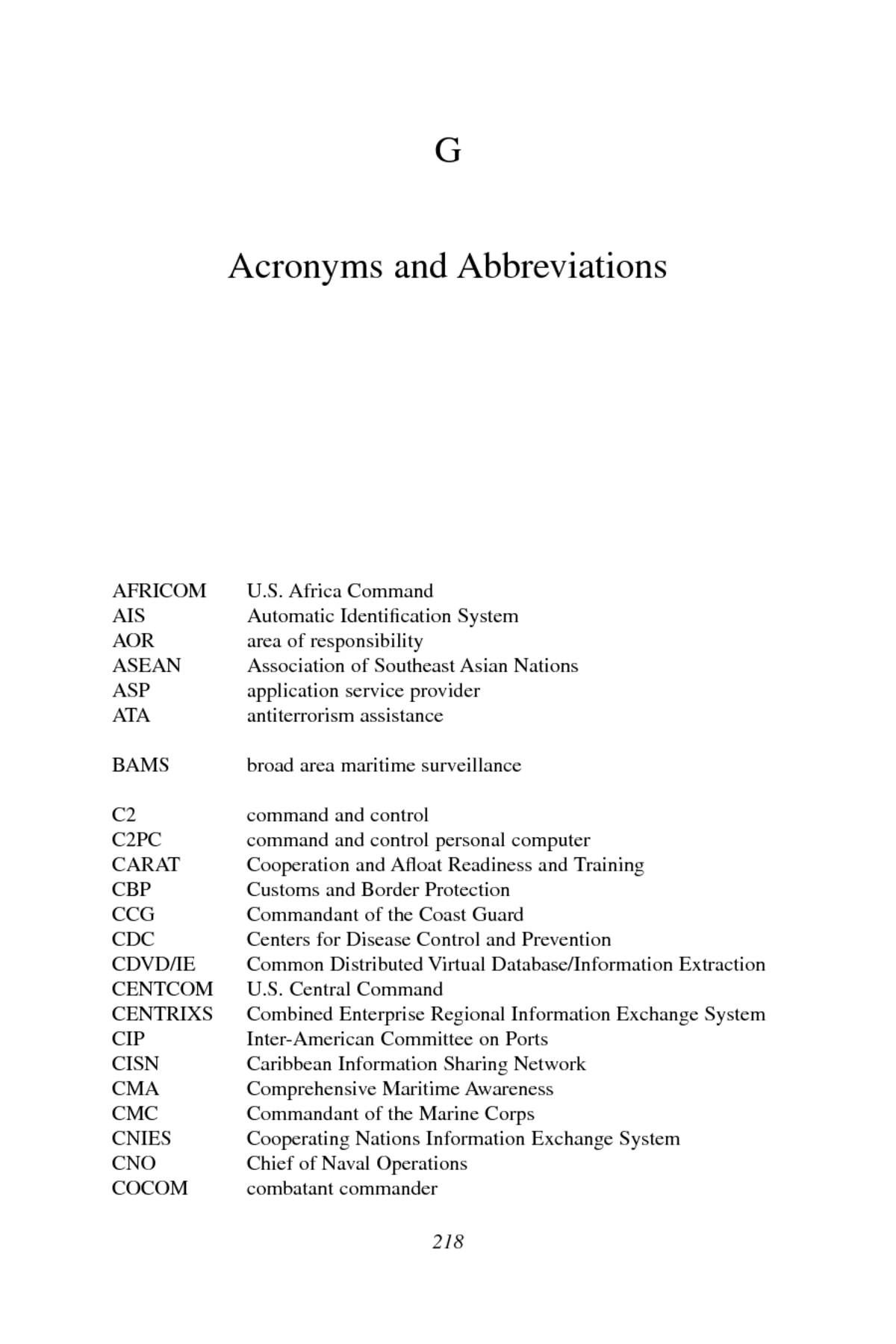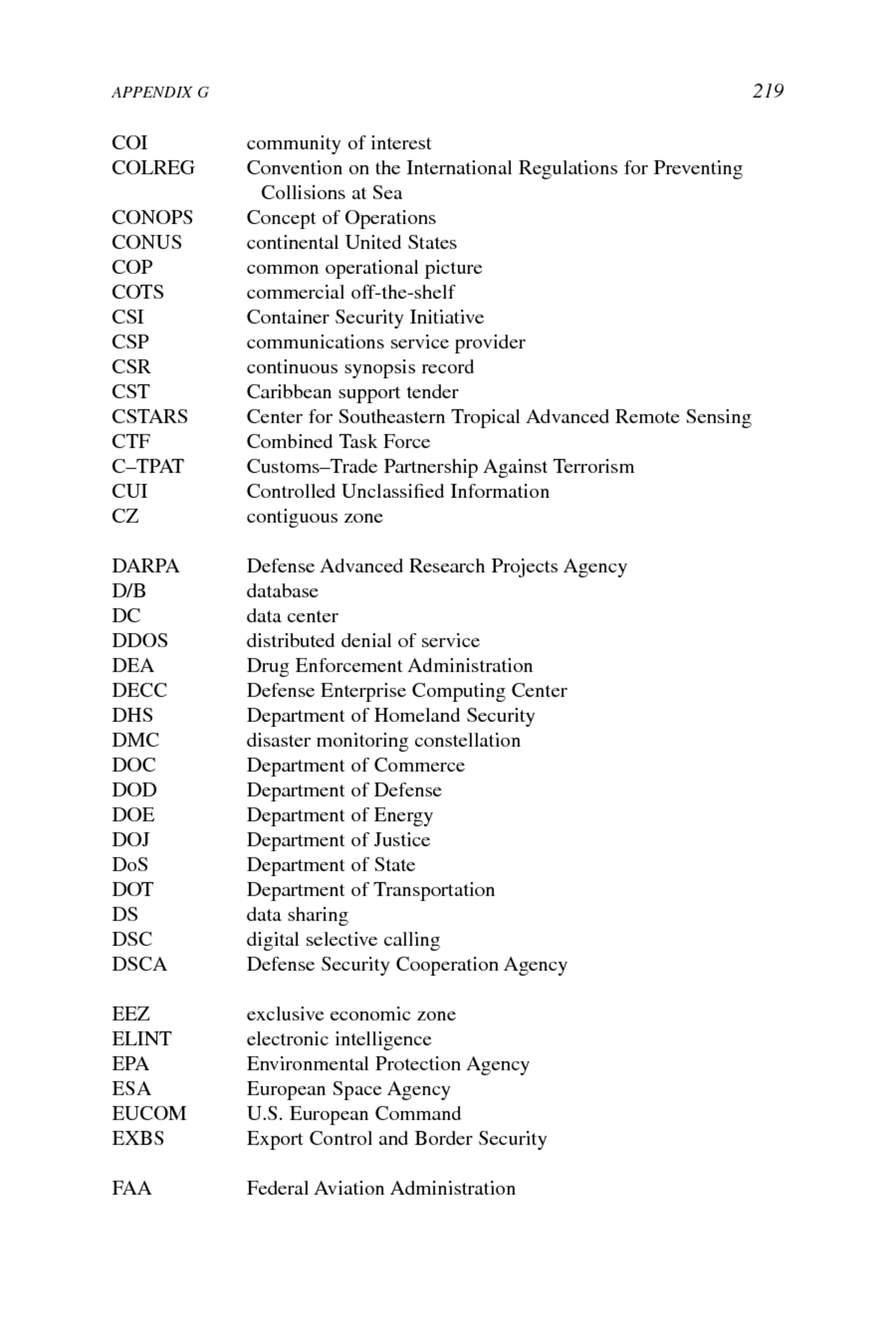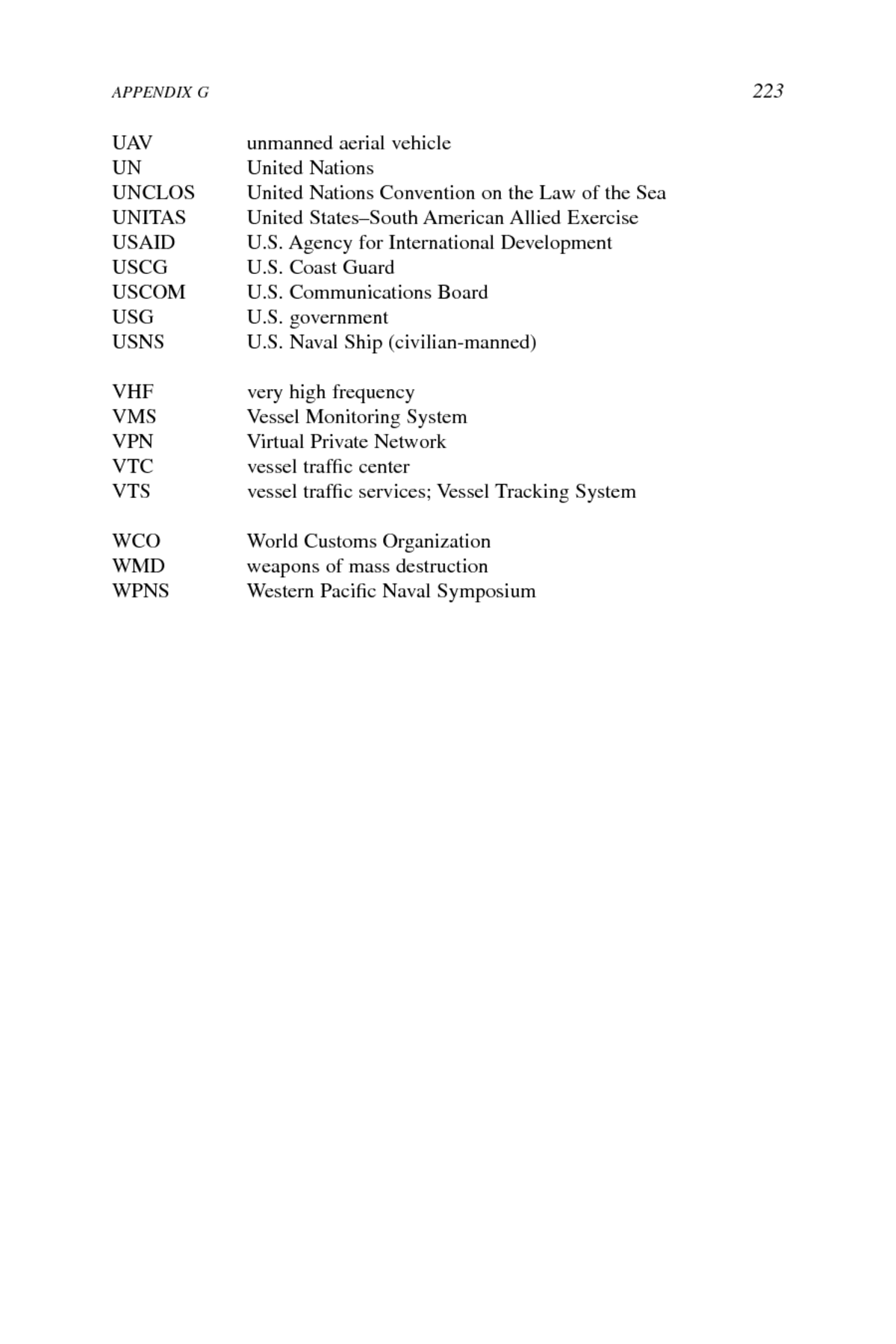Below is the uncorrected machine-read text of this chapter, intended to provide our own search engines and external engines with highly rich, chapter-representative searchable text of each book. Because it is UNCORRECTED material, please consider the following text as a useful but insufficient proxy for the authoritative book pages.
G Acronyms and Abbreviations AFRICOM U.S. Africa Command AIS Automatic Identification System AOR area of responsibility ASEAN Association of Southeast Asian Nations ASP application service provider ATA antiterrorism assistance BAMS broad area maritime surveillance C2 command and control C2PC command and control personal computer CARAT Cooperation and Afloat Readiness and Training CBP Customs and Border Protection CCG Commandant of the Coast Guard CDC Centers for Disease Control and Prevention CDVD/IE Common Distributed Virtual Database/Information Extraction CENTCOM U.S. Central Command CENTRIXS Combined Enterprise Regional Information Exchange System CIP Inter-American Committee on Ports CISN Caribbean Information Sharing Network CMA Comprehensive Maritime Awareness CMC Commandant of the Marine Corps CNIES Cooperating Nations Information Exchange System CNO Chief of Naval Operations COCOM combatant commander 218
APPENDIX G 219 COI community of interest COLREG Convention on the International Regulations for Preventing Collisions at Sea CONOPS Concept of Operations CONUS continental United States COP common operational picture COTS commercial off-the-shelf CSI Container Security Initiative CSP communications service provider CSR continuous synopsis record CST Caribbean support tender CSTARS Center for Southeastern Tropical Advanced Remote Sensing CTF Combined Task Force CâTPAT CustomsâTrade Partnership Against Terrorism CUI Controlled Unclassified Information CZ contiguous zone DARPA Defense Advanced Research Projects Agency D/B database DC data center DDOS distributed denial of service DEA Drug Enforcement Administration DECC Defense Enterprise Computing Center DHS Department of Homeland Security DMC disaster monitoring constellation DOC Department of Commerce DOD Department of Defense DOE Department of Energy DOJ Department of Justice DoS Department of State DOT Department of Transportation DS data sharing DSC digital selective calling DSCA Defense Security Cooperation Agency EEZ exclusive economic zone ELINT electronic intelligence EPA Environmental Protection Agency ESA European Space Agency EUCOM U.S. European Command EXBS Export Control and Border Security FAA Federal Aviation Administration
220 MARITIME SECURITY PARTNERSHIPS FAO foreign area officer; Food and Agriculture Organization (UN) FASTC2AP Fast Connectivity for Coalition Agents Program FBI Federal Bureau of Investigation FIGIS Fisheries Global Information System FOC final operational capability FSA Formal Safety Assessment GENSER General Service GISIS Global Integrated Shipping Information System GMDSS Global Maritime Distress and Safety System GMII Global Maritime Intelligence Integration GMP global maritime partnerships GMSA global maritime situation awareness GOTS government off-the-shelf GT gross ton GWOT global war on terror HARTS Harbor Craft Transponder System HHS Health and Human Services, Department of HLS homeland security HSV high-speed vessel HSVAR High Seas Vessel Authorization Record ICAO International Civil Aviation Organization ICE Immigration and Customs Enforcement ILO International Labor Organization IMET international military education and training IMO International Maritime Organization INMARSAT International Maritime Satellite IOC initial operational capability IP Internet Protocol ISPS International Ship and Port Facility Security IT information technology ITP International Training Program JCTD Joint Concept (Capability) Technology Demonstration JDL Joint Directors of Laboratories JIATF-S Joint Interagency Task Force-South JTD Joint Tactical Demonstration LE law enforcement LEA law enforcement agencies LEDET law enforcement detachment (USCG)
APPENDIX G 221 LRIT Long-Range Identification and Tracking (system) MAGNet Maritime Awareness Global Network MALSINDO Malaysia, Singapore, and Indonesia MARAD Maritime Administration MDA maritime domain awareness MDA DS COI MDA data-sharing community of interest MIO multinational interception operation; maritime interdiction operation MOS military occupation specialty MOTR Marine Operational Threat Response MPA maritime patrol aircraft MSP maritime security partnerships MSPCC Maritime Security Policy Coordinating Committee MSSI Malacca Strait Security Initiative MSSIS Maritime Safety and Security Information System NAIS Nationwide Automatic Identification System NATO North Atlantic Treaty Organization NAVEUR U.S. Naval Forces, Europe NCES Net-Centric Enterprise Services NCIS Naval Criminal Investigative Service NGO nongovernmental organization NMIC National Maritime Intelligence Center NOA notice of arrival NOAA National Oceanic and Atmospheric Administration NORTHCOM U.S. Northern Command NRO National Reconnaissance Office NSC National Security Council NSMS National Strategy for Maritime Security NSPD National Security Presidential Directive NVOCC nonvessel operating common carrier OAE Operation Active Endeavor OAS Organization of American States ODNI Office of the Director of National Intelligence OMP Office of Manpower and Personnel ONI Office of Naval Intelligence OSD Office of the Secretary of Defense ONR Office of Naval Research OTH over the horizon OTH-B over-the-horizon-backscatter OTHR over-the-horizon radar
222 MARITIME SECURITY PARTNERSHIPS P&I protection and indemnity PACOM U.S. Pacific Command PANDA Predictive Analysis for Naval Deployment Activities PCL printer control language PEO program executive office PFP Partnership for Peace PSI Proliferation Security Initiative QoS quality of service RDT&E research, development, test, and evaluation ReCAAP Regional Cooperation Agreement on Combating Piracy and Armed Robbery against Ships in Asia REDICA Central American Information Sharing Network ReMIX Regional Maritime Information Exchange RF radio frequency RFMO Regional Fisheries Management Organization RIMPAC Rim of the Pacific RMAC Regional Maritime Awareness Capability RMP Regional Maritime Partnership RMSP Regional Maritime Security Program ROEs rules of engagement ROTHR relocatable over-the-horizon radar SA situational awareness SAR search and rescue SBU/CUI Sensitive But Unclassified/Controlled Unclassified Information SCI sensitive compartmented information SEI specific emitter identification SLOC sea lane of commerce SOA service-oriented architecture SOLAS International Convention for the Safety of Life at Sea SOUTHCOM U.S. Southern Command SRS Ship Reporting System SSL Secure Sockets Layer SSP sea situation picture SUA Suppression of Unlawful Acts (Convention) SURNET South American Information Sharing Network TDMA time division multiple access TLS Transport Layer Security TRIM Translingual Instant Messaging TSC theater security cooperation
APPENDIX G 223 UAV unmanned aerial vehicle UN United Nations UNCLOS United Nations Convention on the Law of the Sea UNITAS United StatesâSouth American Allied Exercise USAID U.S. Agency for International Development USCG U.S. Coast Guard USCOM U.S. Communications Board USG U.S. government USNS U.S. Naval Ship (civilian-manned) VHF very high frequency VMS Vessel Monitoring System VPN Virtual Private Network VTC vessel traffic center VTS vessel traffic services; Vessel Tracking System WCO World Customs Organization WMD weapons of mass destruction WPNS Western Pacific Naval Symposium







